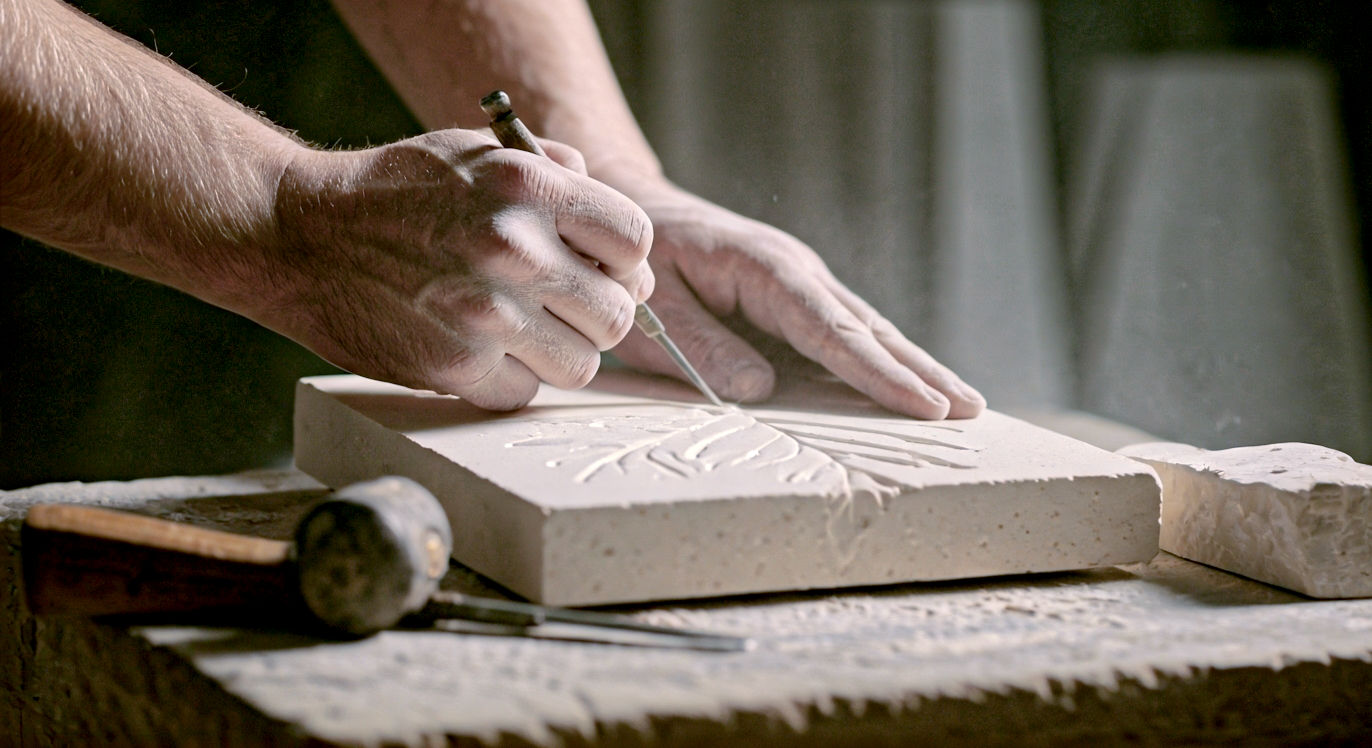The Great British Guide to Stone Carving: From Ancient Craft to Modern Art
Discover the ancient art of stone carving. This ultimate beginner’s guide for the UK covers history, essential tools, stone types, and a step-by-step first project.

This post may contain affiliate links. If you make a purchase through these links, we may earn a commission at no additional cost to you.
Ever stood before a great cathedral, a weathered country church, or even a simple, elegant headstone and marvelled at the shapes and letters coaxed from solid rock? That’s the magic of stone carving. It’s an art form as old as humanity itself, a conversation between a craftsperson and the very bones of the earth. It’s written into our landscape, from the mysterious circles of Stonehenge to the proud lions of Trafalgar Square.
You might think it’s a craft reserved for master artisans with years of training, but you’d be wrong. At its heart, stone carving is about patience, a bit of vision, and the simple, satisfying act of removing one small piece of stone at a time to reveal a form hiding within. It’s a skill you can learn, a hobby that connects you to an ancient lineage of makers, and a wonderfully mindful way to create something real and lasting with your own two hands.
This guide is your starting point. We’re not going to get bogged down in overly technical jargon. Instead, we’ll walk you through everything a curious beginner in Britain needs to know. We’ll cover the incredible history etched into our nation’s stone, help you choose the right rock to work with, introduce you to your essential toolkit, and guide you, step-by-step, through your very first carving. So, grab a cup of tea, and let’s get ready to make your mark.
What Exactly Is Stone Carving?
First things first, let’s clear up what we’re talking about. Stone carving is a type of sculpture. But while a sculptor might model with clay (an additive process where you build up a form), a carver does the opposite. Stone carving is a subtractive process. You start with a block of stone and take bits away until you’ve uncovered the shape you want.
You can’t stick a piece back on if you make a mistake, which sounds a bit daunting! But it’s also what makes it so special. It forces you to think ahead, to be deliberate, and to respect the material you’re working with. Every tap of the mallet is a decision.
There are two main ways to go about it:
- Relief Carving: This is where you carve a picture or pattern onto a flat surface, so it stands out from a background. Think of the carvings on a decorative fireplace or the side of a historic building. The design is attached to the stone block.
- Carving in the Round (Full 3D): This is a freestanding sculpture, like a statue of a person or an animal. You can walk all the way around it and see it from every angle. This is more complex because you have to make it look right from all sides.
For a beginner, relief carving is the perfect place to start. It lets you get a feel for the tools and the stone without having to worry about the complexities of a full 3D form just yet.
A Rich British History, Carved in Stone
You can’t talk about stone carving in Britain without appreciating its incredible history. We live on an island where stories have been told in stone for thousands of years.
The Dawn of Carving: Neolithic Britain
Long before the Romans arrived, people were shaping stone here. The most famous examples are, of course, Stonehenge and Avebury. While not intricately carved in the way we think of today, these massive stones were shaped and dressed using basic stone tools called mauls. Even earlier, Neolithic people carved strange, spiral patterns and cup marks into rocks. These carvings, found in places like Northumberland and Kilmartin Glen in Scotland, are mesmerising and mysterious; we don’t fully know what they meant, but they are our earliest connection to this craft.
Romans, Celts, and Saxons
The Romans brought their sophisticated carving skills with them, leaving behind beautifully inscribed columns and altars, many of which you can still see in places like Bath and along Hadrian’s Wall. After they left, a distinct Anglo-Saxon style emerged. Think of the incredible stone crosses, like the Ruthwell Cross in Dumfriesshire or the Bewcastle Cross in Cumbria. They are covered in swirling patterns of vines and animals, alongside carved figures telling biblical stories. It was a powerful way to communicate in a time when few people could read.
The Golden Age: Medieval Cathedrals
The Norman Conquest kicked off a massive building boom. For the next few hundred years, Britain’s landscape was transformed by the construction of our great cathedrals and abbeys: Canterbury, Lincoln, Salisbury, York Minster. This was the golden age of the stonemason.
Anonymous craftsmen spent their entire lives carving everything from the soaring arches and vaulted ceilings to the tiny, often humorous, details. They carved saints and kings, angels and demons. They also carved gargoyles to spook evil spirits (and act as fancy drainpipes) and funny little figures called ‘grotesques’ hidden in quiet corners. These medieval masons were masters of storytelling, turning entire buildings into stone picture books for everyone to see.
From Renaissance to Modern Art
After the medieval period, carving styles changed with the fashion. Grand country houses were adorned with classical-style carvings. In the Victorian era, there was a huge revival of Gothic style, and our cities were decorated with elaborate stone facades.
In the 20th century, British artists reinvented stone carving. Sculptors like Barbara Hepworth and Henry Moore moved away from purely realistic figures. They were inspired by the natural shapes of pebbles and bones, and they focused on the pure form and texture of the stone itself. They wanted you to feel the material, not just see a picture of something. Their beautiful, abstract works, often seen in places like the Yorkshire Sculpture Park, changed how we think about stone sculpture forever.
Today, the craft is alive and well. Skilled conservationists work to preserve our historic buildings, while modern artists continue to push the boundaries of what’s possible with this ancient and noble material. When you pick up a chisel, you’re joining this long, unbroken line of British craftspeople.
Choosing Your First Stone: A Beginner’s Guide
Choosing the right stone is one of the most important first steps. You don’t want to start with something incredibly hard like granite—that would be like trying to learn to drive in a Formula 1 car. For beginners in the UK, there are some fantastic, softer stones that are a real joy to carve.
The hardness of stone is measured on the Mohs scale, from 1 (Talc, very soft) to 10 (Diamond, very hard). For your first project, you want something in the 2 to 4 range.
Here are the best choices, all quarried right here in the UK:
Portland Stone (Dorset)
- What it’s like: A beautiful, creamy-white limestone. It’s probably the most famous British building stone. You’ll see it everywhere in London, used for landmarks like St Paul’s Cathedral and Buckingham Palace.
- Why it’s great for beginners: It’s relatively soft and has a very consistent, fine grain with few shells or fossils. This means it behaves predictably under the chisel, making it easier to carve fine details without the stone suddenly breaking.
- Hardness: Around 3 on the Mohs scale.
Bath Stone (Somerset)
- What it’s like: Famous for its warm, honey colour that gives the city of Bath its distinctive look.
- Why it’s great for beginners: Like Portland stone, it’s a limestone that’s soft and easy to work when first quarried. It’s very forgiving and allows you to learn the basic cuts without a huge struggle. It can have more shells and fossils than Portland, which can be a fun feature or a slight challenge.
- Hardness: Around 3 on the Mohs scale.
Caen Stone (Imported from France, but historically important)
- What it’s like: A light, creamy-yellow limestone. It’s not British, but it has a huge historical connection to the UK. The Normans loved it and imported tons of it to build things like the Tower of London and Canterbury Cathedral.
- Why it’s great for beginners: It’s one of the easiest stones to carve, very fine-grained and almost completely free of shells. It’s a bit like carving hard cheese! Many professional carvers use it for highly detailed work.
- Hardness: Around 2-3 on the Mohs scale.
Soapstone (Various sources, including Scotland)
- What it’s like: Not a traditional British building stone, but fantastic for beginners. It’s made mostly of talc, making it incredibly soft. It comes in a range of colours, from milky greens and greys to blacks, often with beautiful marbling.
- Why it’s great for beginners: You can carve it with simple hand tools, sometimes even just rasps and files. It’s a great way to understand 3D form without needing a full set of chisels and mallets. It also polishes up beautifully with wax to a deep, rich lustre.
- Hardness: Very soft, around 1-2 on the Mohs scale.
Where can you buy stone? You won’t find carving stone at your local B&Q. You’ll need to go to a specialist supplier. A quick search online for “stone carving suppliers UK” or “masonry suppliers” will bring up several companies. They can cut a block to the size you need (a small block, say 6x6x4 inches, is perfect for a first go) and even post it to you. Don’t be afraid to ring them up and say you’re a beginner; they are usually very happy to advise.
The Essential Toolkit: Your First Set of Tools
Walking into a tool shop can be overwhelming. There are hundreds of different chisels and hammers. The good news is, you only need a few key items to get started. Don’t buy a massive, cheap set online. It’s much better to buy three or four good-quality tools that will last you a lifetime. Look for brands like Guillet or T&H Falciani.
Here’s your starter kit:
1. The Mallet (or Dummy)
This isn’t a hammer! A carver’s mallet has a rounded head. This shape means that no matter how you hold it and strike the chisel, you’re likely to make good contact. It also gives a slightly softer, more controllable ‘thud’ than a sharp hammer blow.
- Beginner’s choice: A nylon dummy mallet. They are durable, kind to your chisels (and your ears!), and don’t bounce as much as wooden ones. A weight of around 1.5 lbs (or 700g) is a great place to start.
2. The Chisels
Your chisels are what do the real work. They are made of high-quality steel with a tungsten carbide tip (TCT). The tungsten is incredibly hard and holds a sharp edge for much longer than plain steel. For a beginner working on limestone, three chisels will get you a surprisingly long way.
- The Point Chisel: This is your roughing-out tool. As the name suggests, it comes to a point. You use it to knock off the corners and remove large amounts of unwanted stone quickly. It’s for blocking out the basic shape of your design. Think of it as your sketch pencil.
- The Claw Chisel (or Toothed Chisel): This chisel has a flat end with several teeth (usually four or five). After you’ve roughed out the shape with the point, you use the claw to further refine the form and smooth out the deep furrows left by the point. The teeth rake away stone, a bit like a garden claw tool. It’s your modelling tool.
- The Flat Chisel (or Bolster): This is for creating flat surfaces and sharp, crisp lines. After the claw has done its work, you use the flat chisel to get the final smooth finish. It’s your finishing tool. A 10mm or 15mm wide flat chisel is a very useful starting size.
3. Rifflers and Rasps
These are like files for stone. Rifflers are double-ended tools with shaped, toothed ends. They come in all sorts of profiles (curved, flat, pointed) and are brilliant for getting into awkward corners, smoothing out curves, and adding fine details that are too delicate for a chisel. A small set of diamond rifflers can be a great investment.
4. Safety Gear – NON-NEGOTIABLE!
This is the most important part of your toolkit. Stone dust is seriously bad for your lungs, and flying stone chips can blind you.
- Eye Protection: You must wear safety glasses or goggles at all times. Not sunglasses, proper impact-rated safety glasses.
- Dust Mask: Stone dust contains silica, which can cause a permanent, debilitating lung disease called silicosis. You must wear a dust mask rated FFP3 (or P3). A simple paper mask is not good enough. It needs to be a proper respirator that fits your face snugly.
- Gloves: Sturdy work gloves will protect your hands from blisters and scrapes.
- Steel-Toe Boots: If you’re working with larger blocks of stone, these are essential to protect your feet.
Your First Carving Project: A Step-by-Step Guide
Right, you’ve got your stone, your tools, and your safety gear. It’s time for the exciting bit. We’re going to carve a simple shape in relief—a leaf is a classic first project.
Step 1: Set Up Your Workspace
You don’t need a massive workshop. A sturdy workbench in a well-ventilated garage, shed, or even a corner of the garden on a dry day is perfect. The key is ventilation to let the dust escape.
You’ll need a banker, which is just a solid, stable surface to work on. A sawn-off tree stump is traditional, but a stack of wooden pallets or a very sturdy workbench will do. You want it at a comfortable height, usually around your waist, so you’re not bending over. Place a sandbag or some old rags on the banker to cushion your stone and stop it from sliding around.
Step 2: Get Your Design Ready
Draw a simple leaf shape on a piece of paper. Don’t make it too complicated for your first go—a simple oak or maple leaf shape is perfect. Cut it out to make a template.
Place your template on the flattest face of your stone block and draw around it with a soft pencil. You can then use a permanent marker to go over the pencil line so it doesn’t rub off.
Step 3: Safety First!
Put on your goggles, your FFP3 dust mask, and your gloves. Do it now. Don’t even think about tapping the stone until you are wearing them.
Step 4: Roughing Out (The Point Chisel)
Our goal is to lower the entire surface of the stone around the leaf, making the leaf shape stand out.
- Hold the point chisel in your non-dominant hand (your ‘listening’ hand), and the mallet in your dominant hand (your ‘talking’ hand). Don’t grip the chisel too tightly; hold it firmly but with a little bit of play.
- Start about half an inch away from your leaf outline. Angle the chisel at about 45 degrees, pointing away from the line.
- Give the chisel a firm, confident tap with the mallet. Don’t whack it with all your might, but don’t be timid either. You’ll see a chip of stone fly off. Good! That’s the whole point.
- Work your way around the outline, always pointing the chisel away from your design. This is called ‘pitching’. It creates a rough border and protects your precious leaf shape from accidentally splitting.
- Once you have a trench around your leaf, you can start removing the rest of the background stone with the point chisel. Work across the surface, lowering it bit by bit to a consistent depth, maybe half an inch to start with.
Top Tip: The sound tells you everything. A crisp ‘tink’ is a good cut. A dull ‘thud’ means the chisel is buried too deep or at the wrong angle.
Step 5: Shaping and Smoothing (The Claw Chisel)
Your surface will now look rough and hilly from the point chisel. It’s time to bring in the claw.
- Hold the claw chisel at a lower angle, almost parallel to the stone surface.
- Work systematically across the background, breaking down the ridges left by the point. The claw will act like a rake, evening everything out.
- You can also start to add a little shape to your leaf. Gently round over the edges to get rid of the sharp, blocky look. Think about how a real leaf isn’t perfectly flat—it has curves.
Step 6: Finishing Touches (The Flat Chisel and Rifflers)
Now for the final stage. The flat chisel will give you a cleaner background and crisper edges.
- Use the flat chisel to carefully pare away the marks left by the claw, creating a smoother background.
- You can define the outline of your leaf more sharply. Place the corner of the flat chisel on your line and give it a gentle tap to create a crisp edge.
- Now, add the veins of the leaf. Draw them on with a pencil first. Then, you can use the corner of your flat chisel or a V-shaped riffler to gently carve them in.
- Use your rifflers and some sandpaper (for stone, use ‘wet and dry’ paper) to smooth any areas you want to refine.
Step 7: Stand Back and Admire!
Brush off the dust, take off your gear, and have a look. You’ve done it! You’ve taken a plain block of stone and turned it into something new. It won’t be perfect, and that’s more than okay. Your first carving is a record of your learning. Be proud of it.
Where to Go From Here: Taking the Next Step
Once you’ve got the carving bug, you’ll be keen to learn more. Here are some great British resources to help you on your journey:
- Take a Course: The best way to learn is from an expert. Look for weekend or week-long stone carving courses. Places like the City & Guilds of London Art School, West Dean College in Sussex, and many local colleges and art centres run excellent courses for beginners.
- Read Up: There are some fantastic books on the subject. The Art of Letter Carving in Stone by Tom Perkins is a classic for letter cutting, and Sculpture in Stone by John Tiranti is a great general guide.
- Join a Community: Look online for forums or local groups of carvers. Sharing your work and getting advice from others is a brilliant way to improve.
- Just Keep Carving: The most important thing is practice. Buy another block of stone. Try carving a letter—your initial is a good place to start. Try a simple animal shape. With every project, your confidence and skill will grow.
Stone carving is a journey, not a destination. It’s a slow, meditative craft that rewards patience and persistence. It connects you to history, to geology, and to your own creativity. In a world of fast clicks and temporary digital content, there is something profoundly satisfying about creating an object that could, quite literally, last for a thousand years. So go on, pick up a chisel, and carve your own story in stone.
Further Reading & Resources
For those ready to delve deeper, these resources are highly respected in the UK stone carving community:
- The Lettering Arts Trust: An essential resource for anyone interested in the art of letter carving, offering courses, exhibitions, and information. www.letteringartstrust.org.uk
- City & Guilds of London Art School: One of the premier institutions in the UK for learning historic crafts, with outstanding courses in stone carving and masonry. www.cityandguildsartschool.ac.uk
- Alec Tiranti Ltd: A leading UK supplier for all your sculpture and carving needs, from stone and tools to books and safety equipment. A great source for quality beginner’s tools. www.tiranti.co.uk
- Yorkshire Sculpture Park: For inspiration, there’s no better place to see how modern masters like Barbara Hepworth and Henry Moore worked with stone. www.ysp.org.uk






